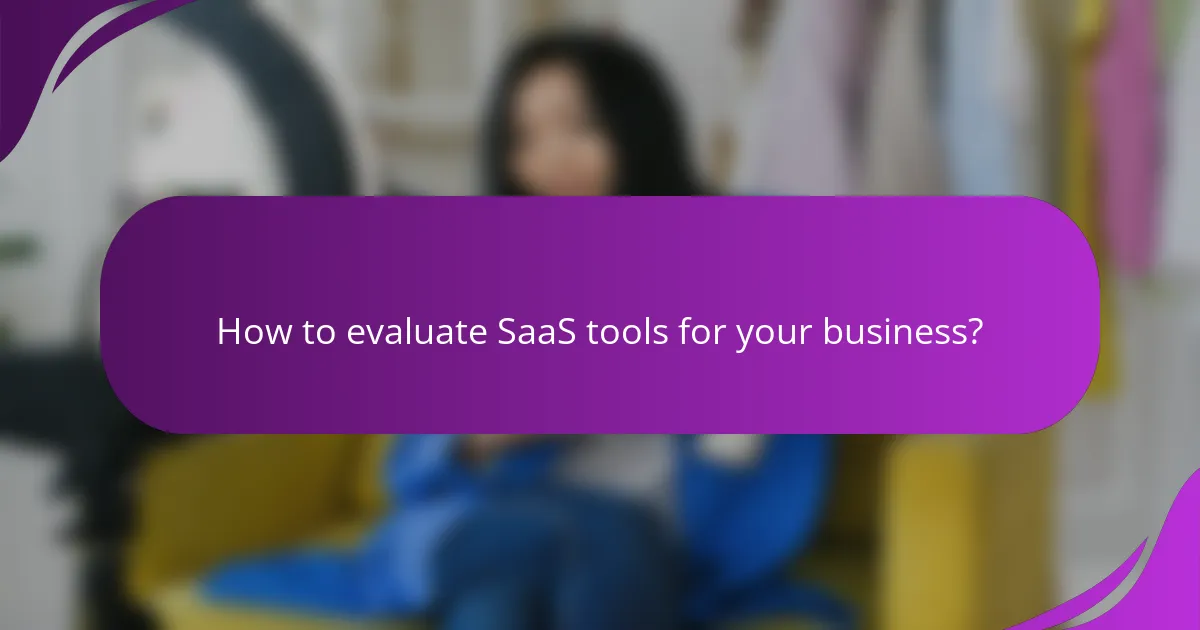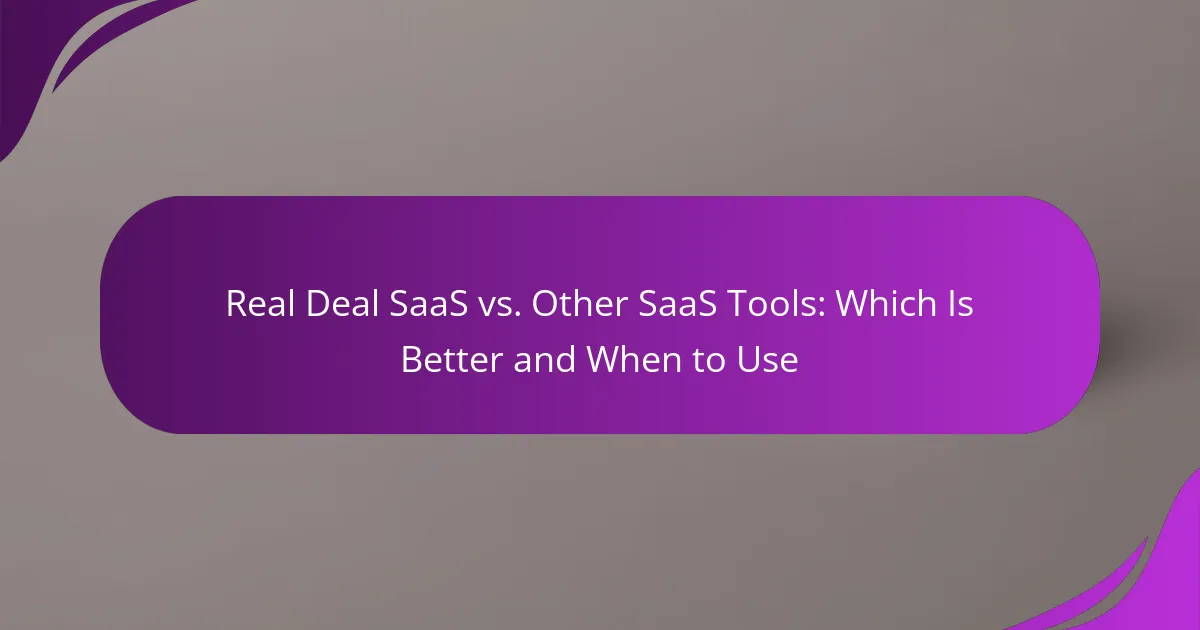When choosing between Real Deal SaaS and other SaaS tools, it’s essential to understand the unique advantages each option offers. Real Deal SaaS excels in cost-effectiveness, scalability, and user-friendly interfaces, making it ideal for businesses seeking comprehensive solutions. This platform is particularly beneficial for organizations that require robust features and reliable support, ensuring seamless integration with existing systems.

What are the advantages of Real Deal SaaS?
Real Deal SaaS offers several key advantages, including cost-effectiveness, scalability, user-friendly interfaces, and robust customer support. These benefits make it an attractive option for businesses looking to optimize their software solutions.
Cost-effectiveness
Real Deal SaaS typically operates on a subscription model, allowing businesses to avoid hefty upfront costs associated with traditional software. This pay-as-you-go structure can lead to significant savings, especially for small to medium-sized enterprises.
Additionally, many Real Deal SaaS solutions offer tiered pricing plans, enabling companies to choose a package that aligns with their budget and needs. This flexibility ensures that businesses only pay for the features they use, further enhancing cost efficiency.
Scalability
One of the standout features of Real Deal SaaS is its scalability. As a business grows, its software needs often change, and Real Deal SaaS can easily accommodate this growth without requiring extensive infrastructure changes.
Many platforms allow users to upgrade their plans seamlessly, adding more users or features as needed. This adaptability is crucial for businesses aiming to expand without facing the limitations of traditional software solutions.
User-friendly interface
Real Deal SaaS solutions are designed with user experience in mind, often featuring intuitive interfaces that require minimal training. This user-friendliness can lead to quicker adoption rates among employees, reducing downtime and increasing productivity.
Moreover, many platforms prioritize mobile accessibility, allowing users to access tools from various devices. This convenience enhances collaboration and ensures that teams can work efficiently from anywhere.
Robust customer support
Effective customer support is a hallmark of Real Deal SaaS offerings. Most providers offer multiple support channels, including live chat, email, and phone support, ensuring that users can get assistance when needed.
Additionally, many platforms provide extensive documentation, tutorials, and community forums. This wealth of resources empowers users to troubleshoot issues independently, further enhancing the overall user experience.

When should I choose Real Deal SaaS over other tools?
Choose Real Deal SaaS when you need a comprehensive solution that integrates seamlessly with your existing systems and scales with your business. It is particularly beneficial for organizations looking for robust features and reliable support, as opposed to simpler, less integrated tools.
For small business needs
Small businesses often require tools that are both cost-effective and easy to use. Real Deal SaaS typically offers a range of features that can be tailored to specific business needs, allowing small enterprises to manage operations efficiently without overwhelming complexity.
When selecting a SaaS tool, consider the essential functionalities your business requires. For example, if you need customer relationship management (CRM) and invoicing, ensure the Real Deal SaaS solution provides these features in one package, reducing the need for multiple subscriptions.
During rapid growth phases
During periods of rapid growth, businesses face unique challenges that require scalable solutions. Real Deal SaaS can adapt to increasing demands, offering flexibility in user capacity and feature sets that can expand as your business evolves.
Evaluate how quickly you anticipate growth and choose a SaaS solution that can accommodate that pace. Look for options that allow for easy upgrades and additional features without significant downtime or migration hassles.
For budget-conscious projects
For projects with tight budgets, Real Deal SaaS can provide a comprehensive solution without the high upfront costs associated with traditional software. Many Real Deal SaaS options offer subscription models that allow businesses to pay only for what they use, making them financially accessible.
When budgeting, consider not just the subscription fees but also the potential savings from reduced IT overhead and maintenance costs. Compare the total cost of ownership of Real Deal SaaS against other tools to ensure you’re making a financially sound decision.

How does Real Deal SaaS compare to competitors?
Real Deal SaaS typically stands out against its competitors by offering a more comprehensive feature set and competitive pricing. When evaluating which software to use, consider your specific needs, budget, and the unique benefits each platform provides.
Feature set comparison
Real Deal SaaS often includes advanced features such as customizable dashboards, extensive integrations, and robust analytics tools that may not be available in other SaaS solutions. Competitors might offer basic functionalities, but they often lack the depth and flexibility found in Real Deal SaaS.
For example, while some tools provide standard reporting, Real Deal SaaS allows for real-time data visualization and predictive analytics, which can significantly enhance decision-making processes. Assess your requirements to determine if these advanced features justify the investment.
Pricing structure analysis
The pricing structure of Real Deal SaaS is generally competitive, with various tiers designed to accommodate different business sizes and needs. Many competitors may offer lower initial costs but could impose higher fees for essential features or user limits.
When considering pricing, look for hidden costs such as setup fees or charges for additional users. Real Deal SaaS often provides transparent pricing with no surprises, making it easier to budget for long-term use.
Customer satisfaction ratings
Customer satisfaction ratings for Real Deal SaaS are typically high, reflecting its user-friendly interface and responsive customer support. Many users appreciate the platform’s reliability and the effectiveness of its features in real-world applications.
In contrast, some competitors may receive mixed reviews due to issues like poor customer service or limited functionality. Checking user reviews and ratings can provide valuable insights into which SaaS tool may best meet your needs.

What are the key features of Real Deal SaaS?
Real Deal SaaS typically includes features that enhance usability, integration, and customization, making it suitable for various business needs. Key aspects often focus on seamless integration with existing systems, extensive customization options, and robust reporting capabilities that provide actionable insights.
Integration capabilities
Real Deal SaaS solutions are designed to integrate smoothly with a variety of third-party applications and services. This allows businesses to streamline workflows and enhance productivity by connecting tools like CRM systems, payment processors, and marketing platforms.
When evaluating integration capabilities, consider the number of pre-built connectors available and the ease of setting up custom integrations. A strong API can significantly enhance flexibility and adaptability, allowing for tailored solutions that fit specific business processes.
Customization options
Customization is a hallmark of Real Deal SaaS, enabling businesses to tailor the software to their unique requirements. This can range from user interface modifications to specific feature enhancements that align with operational needs.
Look for platforms that offer a user-friendly customization interface, allowing non-technical users to make adjustments without extensive coding knowledge. Additionally, consider the extent of customization available, as some tools may offer limited options compared to others.
Reporting and analytics tools
Robust reporting and analytics tools are essential features of Real Deal SaaS, providing businesses with insights into performance metrics and operational efficiency. These tools often include customizable dashboards, real-time data visualization, and automated reporting capabilities.
When assessing reporting tools, prioritize those that allow for easy data manipulation and export options. The ability to generate reports on key performance indicators (KPIs) can help businesses make informed decisions and identify areas for improvement.

What are the limitations of Real Deal SaaS?
Real Deal SaaS tools come with several limitations that can affect their usability and effectiveness. Understanding these constraints is crucial for businesses to determine when to use them and when alternative solutions may be more appropriate.
Limited advanced features
Real Deal SaaS often lacks advanced features that are available in more robust software solutions. For example, while basic functionalities like project management and collaboration tools are typically included, complex analytics and customization options may be missing.
This limitation can hinder businesses that require specialized tools for data analysis or industry-specific tasks. Companies should assess their needs and consider whether the basic features offered will suffice or if they need to invest in more comprehensive software.
Dependency on internet connectivity
Real Deal SaaS applications are heavily reliant on stable internet connectivity. If the internet goes down or is slow, users may experience disruptions that can affect productivity and workflow.
This dependency means that businesses operating in areas with unreliable internet service may face challenges. It’s advisable to have backup plans, such as offline tools or alternative internet sources, to mitigate potential downtime.
Potential learning curve
While Real Deal SaaS tools are designed to be user-friendly, there can still be a learning curve, especially for teams unfamiliar with cloud-based solutions. Users may need time to adjust to new interfaces and functionalities.
To ease this transition, companies should consider providing training sessions or resources to help employees become proficient. Investing in onboarding can lead to better adoption rates and overall satisfaction with the software.

How to evaluate SaaS tools for your business?
To evaluate SaaS tools effectively, identify your specific business needs and budget constraints. This ensures that the selected software aligns with your operational goals and financial capabilities.
Define business needs
Start by outlining the core functions that the SaaS tool must fulfill. Consider factors such as user requirements, scalability, and integration with existing systems. For example, if your team requires collaboration features, look for tools that prioritize real-time communication and file sharing.
Engage stakeholders from different departments to gather diverse perspectives on what features are essential. This collaborative approach helps in creating a comprehensive list of needs, ensuring that the chosen solution serves the entire organization effectively.
Assess budget constraints
Budget constraints play a critical role in selecting SaaS tools. Determine a realistic budget range that includes not only subscription costs but also potential implementation and training expenses. For instance, a monthly subscription might range from $10 to $100 per user, depending on the complexity of the tool.
Be mindful of hidden costs, such as overage fees or additional charges for premium features. Establish a clear cost-benefit analysis to evaluate whether the investment aligns with your business objectives and expected returns. This will help prevent overspending and ensure that the selected tool provides genuine value.
